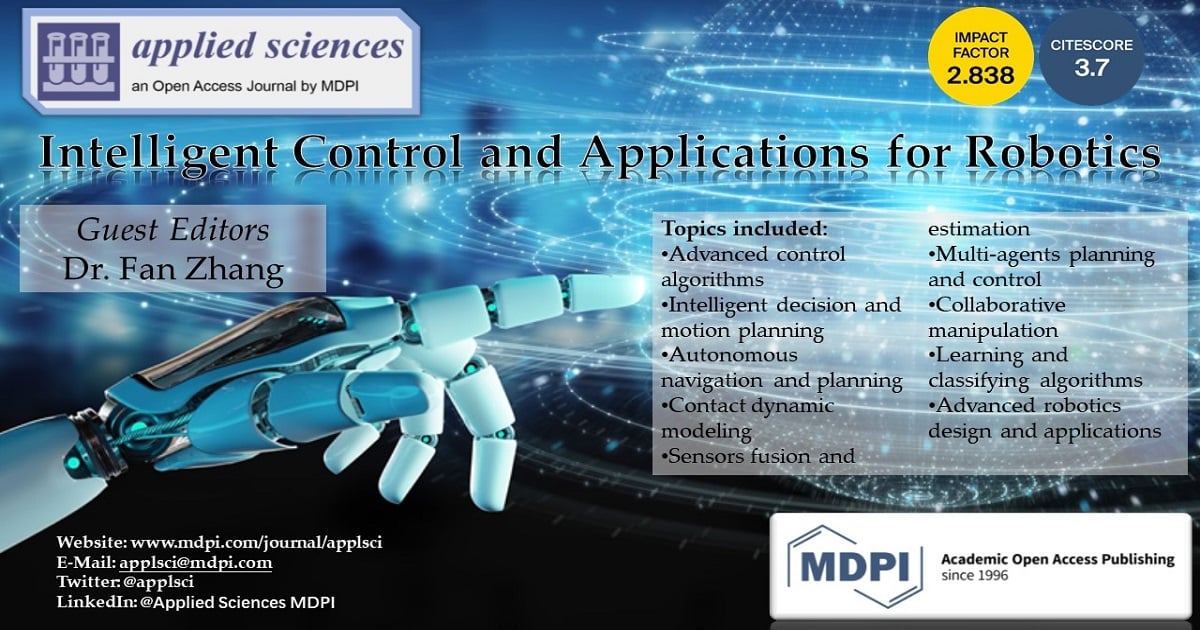Intelligent Control and Applications for Robotics
A special issue of Applied Sciences (ISSN 2076-3417). This special issue belongs to the section "Robotics and Automation".
Deadline for manuscript submissions: closed (30 August 2023) | Viewed by 8053

Special Issue Editor
Interests: dynamics and control of rigid-flexible complex systems; underactuated system dynamics and control; multi-agent mutual positioning, collaborative decision-making planning and control
Special Issue Information
Dear Colleagues,
Robotics can help automate tasks that are repetitive, dangerous, or vulnerable to human error. More and more applications in totally different fields, like UAV, AUV, drones, mobile robots, space robots, for instance, make the robotics more versatile and further complicated. However, automation without intelligence creates a system that cannot respond to variables, new environments, or dynamic requirements. With advanced decision, planning, and control schemes, the plants will enrich the application scenarios.
The aim of this Special Issue is to bring together original research on the related topics.
Potential topics include Aerial Robotics, marine robotics, space robotics, and mobile robotics of the following aspect, but are not limited:
- Advanced control algorithms
- Intelligent decision and motion planning
- Autonomous navigation and planning
- Contact dynamic modeling
- Sensors fusion and estimation
- Multi-agents planning and control
- Collaborative manipulation
- Learning and classifying algorithms
- Advanced robotics design and applications
Dr. Fan Zhang
Guest Editor
Manuscript Submission Information
Manuscripts should be submitted online at www.mdpi.com by registering and logging in to this website. Once you are registered, click here to go to the submission form. Manuscripts can be submitted until the deadline. All submissions that pass pre-check are peer-reviewed. Accepted papers will be published continuously in the journal (as soon as accepted) and will be listed together on the special issue website. Research articles, review articles as well as short communications are invited. For planned papers, a title and short abstract (about 100 words) can be sent to the Editorial Office for announcement on this website.
Submitted manuscripts should not have been published previously, nor be under consideration for publication elsewhere (except conference proceedings papers). All manuscripts are thoroughly refereed through a single-blind peer-review process. A guide for authors and other relevant information for submission of manuscripts is available on the Instructions for Authors page. Applied Sciences is an international peer-reviewed open access semimonthly journal published by MDPI.
Please visit the Instructions for Authors page before submitting a manuscript. The Article Processing Charge (APC) for publication in this open access journal is 2400 CHF (Swiss Francs). Submitted papers should be well formatted and use good English. Authors may use MDPI's English editing service prior to publication or during author revisions.
Keywords
- advanced control algorithms
- intelligent decision and motion planning
- autonomous navigation and planning
- contact dynamic modeling
- sensors fusion and estimation
- multi-agents planning and control collaborative manipulation
- learning and classifying algorithms
- advanced robotics design and applications





